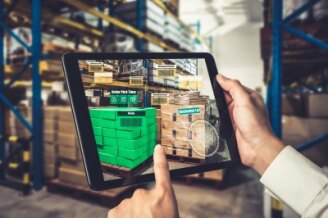
Five Trends In Warehouse Management
Warehouse management software developers introduce new capabilities and concepts all the time to meet demand for improved performance, productivity, and efficiency, Cold Chain Federation member Principal Logistics Technologies. While many of the changes in any given period are incremental there are always overarching trends which tend to drive innovation and change harder and faster in particular directions. Currently, much of the attention is focused on what might broadly be termed as “automation” or “better use of data”.
Warehouse Robotics and Automation: robots have been used in warehouses for years, but their form and capabilities continue to evolve. From articulated robotic arms to automated guided vehicles (AGVs) and autonomous mobile robots (AMRs), robotics are increasingly used for tasks like picking, packing, inventory management, and transportation. Systems are inevitably becoming more sophisticated, incorporating features to support greater autonomy, smarter decision making, and enhanced fleet utilisation among others. The aim as always is to enhance accuracy and operational efficiency while also generating a faster return on what is often considerable investment. Advances in 2024 might include improvements to robotic guidance systems, leading to wider adoption across warehouses, and better integration with employees to enable use across all areas of the warehouse. This final point was reiterated in Gartner’s recent report on current trends in supply chain technology.
Big Data and Data Warehouses: modern WMS and other supply chain applications generate a huge amount of data. Until recently, most businesses either did not recognise the potential uses of this data or had no way of releasing its value. Now they are beginning to leverage data analytics to optimise processes, improve inventory management, and enhance decision-making. Leading WMS now include features or modules to promote the efficient storage, retrieval, and analysis of large volumes of data, enabling better insights and informed supply chain strategies.
Computer Vision: it could be argued that barcode scanners were the forerunners of computer vision, enabling WMS and other warehouse systems to “read” information about items entering and moving through the warehouse. But modern computer vision systems go much further, using cameras and sensors to capture visual data which can be analysed for various purposes. For example, they can help with tasks such as quality control where they can detect damaged or faulty products and packaging. In some applications they can identify specific items to help with sortation and picking. There is no doubt and innovative suppliers and their customers will find new ways to use the technology in the future.
Blockchain Technology: this is revolutionising how warehouse and supply chain data is managed and transactions are conducted. Its underlying concepts are similar to the worldwide patented Unique Referencing (UR) mechanism that Principal Logistics Technologies developed some years earlier and which form the backbone of its product suite. Blockchain supports inventory management traceability and transparency by creating an immutable ledger of inventory movements where each transaction, from receiving goods to shipping, is recorded to provide real-time visibility. All stakeholders can track a product’s journey from source to destination. It can enable smart contracts by automating processes such as payment, delivery confirmation, and quality checks. The decentralised nature of blockchain prevents fraudulent alterations to records, enhancing security and trust. This promotes and enhances collaboration because participants – warehouses, manufacturers, suppliers – connect through a shared record, streamlining operations and improving efficiency. In 2024, more warehouses will likely explore blockchain for secure transactions, provenance tracking, and supply chain visibility.
Artificial Intelligence (AI): much has been written about AI in the last 18 months and whether or not it is currently being used widely in the supply chain its potential is clear. According to some reports, as much as $100 billion has been invested worldwide in the technology during this timeframe. AI algorithms can transform warehouse operations in areas such as optimising pick routes and paths, predicting demand, and automating decision-making. Expect AI-driven solutions for demand forecasting, inventory optimisation, and route planning to become more prevalent in 2024.
These are some of the trends that will drive innovation in warehouse operations and the applications such as WMS that support them. In reality, few of these technologies are deployed in isolation because they are in many respects interrelated. For example, although it is possible to analyse large volumes of data using conventional techniques to reveal hidden patterns which lead to new insights, much more can be achieved and faster when this analysis is conducted with the help of AI. Similarly, advances in vision systems are providing robotics and automation equipment with greater capabilities to understand their working environment and to identify products (through shape and pattern recognition) more quickly. Blockchain is helping to secure and protect the ever-larger volumes of data that are generated across the board. And, of course, all these technologies have at least some aspects that overlap or interface with the modern WMS applications that underpin the operations of countless warehouses.

Comments are closed.
